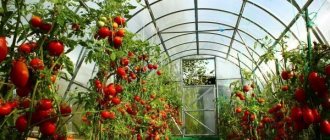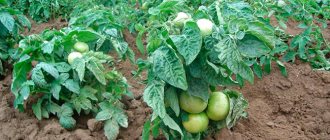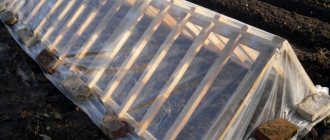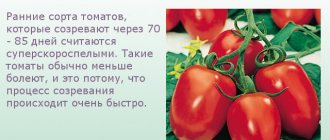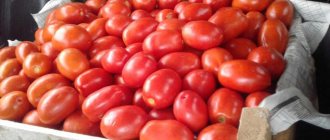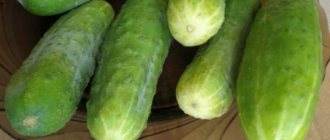In any climate zone, but especially in regions with long spring frosts and short summers, it is advisable to grow tomatoes in polycarbonate greenhouses. This material transmits heat and light well, but does not allow cold to penetrate into the room, and is distinguished by its low price and plasticity.
In protected soil you can get a guaranteed high yield, however, the requirements for greenhouse tomatoes are special. They should be resistant to most diseases and tolerate high humidity and temperature. Therefore, it will be useful for novice vegetable growers to find out which varieties and hybrids are best grown in polycarbonate greenhouses. This article will provide an overview of the best tomatoes for protected soil.
Ural
Titanic
Titanic tomatoes have been grown in the Southern Urals for a long time. This is a mid-season hybrid variety. The ripening period is 120 days. The height of the bush reaches 44-54 centimeters. Grown only in a greenhouse. It does not germinate and bear fruit well in open beds.
The tomatoes are medium in size, weighing no more than 115 g. They have elastic, dark brown skin. The taste is sweet, without sourness. With proper planting and care, one bush can produce up to 6 kg of tomatoes.
Kostroma
Many gardeners prefer this tomato variety for its excellent taste. Kostroma tomatoes are used in preparing various dishes. They are suitable for adding to marinades.
Kostroma tomatoes ripen quickly. The gardener will receive the first harvest 90 days after sowing. A ripe tomato weighs up to 134 g, the skin is thin and red. You can remove up to 6 kg of fruit from one bush.
Wonderful lady
In the Siberian region, this hybrid is planted exclusively in a greenhouse. The growth period is 100-105 days. After this time, medium-sized tomatoes with fleshy burgundy-colored pulp appear on the plants.
The Fair Lady tomato is a low-growing plant. The height of the bush reaches 45-50 cm. This feature allows you to do without additional supports and garters. The variety is resistant to most tomato diseases found in the Urals.
Banana legs
A greenhouse hybrid that can be successfully grown in the Urals. It has tasty, yellow, elongated fruits with a pointed end. The taste has a pleasant citrus note. Tomatoes are not prone to cracking, so they are widely used for pickling. Tomatoes appear on the branch 100 days after planting.
The bush grows up to 1 m in height. It does not require mandatory pinching, but experienced gardeners shape the plant up to the first cluster - this allows them to get an earlier harvest.
Pink honey
This variety is characterized by early ripening. The productivity of Rose honey is 3.7 kg/sq. m. Bushes up to 1.5 m high produce a small amount of dark green leaves and up to 6 kg of fruit. The variety is recommended for cultivation with the development of two shoots.
Disease resistance is average. The first tomatoes can weigh up to 1.5 kg, and subsequent ones - up to 800 g. The shape of the fruit is heart-shaped, slightly ribbed. The internal structure suggests the presence of more than 4 chambers. Rose honey has a fleshy, sweet pulp without sourness.
Tomatoes are suitable for consumption only fresh; they are not suitable for canning due to their large size. They are stored very poorly, so it is recommended to use them immediately after collection.
What should be the feeding and garter?
Tomato plants are fertilized with mineral fertilizers and organic matter. Nitrogen is added 2 weeks after planting, phosphorus fertilizer is added during flowering, and potash is added for fruit growth. Fertilize with organic fertilizers after flowering approximately once every six months. You can feed tomatoes with fermented weeds.
Advice from gardeners: to speed up ripening, place a bucket of humus or manure in the greenhouse; the carbon dioxide released will stimulate the filling and setting of fruits.
You need to tie it to a trellis and pull it up as it grows. If you grow large-fruited tomatoes, then provide enhanced support. Do not forget to remove the stepsons from the leaf axils.
Siberia
Pearl of Siberia
Pearl of Siberia is a relatively new variety of greenhouse tomatoes. It is characterized by high yield and good taste of fruits. This variety was bred by our compatriots in the Siberian Federal District (Novosibirsk region).
The variety is mid-early, fruiting begins 115 days after germination. Fruit ripening occurs from bottom to top. The yield from one plant is about 3 kg, from 1 m2 - about 8 kg. The fruits are slightly elongated cream with a smooth surface, red in color. They have excellent shelf life and transportability, and are not prone to cracking.
It is characterized by good resistance to most diseases (“mosaic”, stem and root cancer, late blight, gray and white rot, etc.).
Siberian lights
This indeterminate tomato variety, created by Siberian breeders, has a whole set of attractive features: high yield (one bunch produces 6-7 fruits), impressive size (fruit weight up to 250 g) and an unusual cuboid shape of tomatoes. Due to their high dry matter content, when processed, they produce excellent juices, colorful and tasty ketchups and tomato pastes.
The fruits are cylindrical, smooth, bright scarlet in color. For their excellent taste they received a tasting rating of “Excellent”. Tomatoes are leveled, transportable and shelf-stable. They are versatile in use - they make excellent summer salads and a variety of preserves.
Cascade
An excellent variety for whole-fruit canning. Siberian Cascade tomatoes surprise with their high yield - from one bush you can get up to 3.5 kg of tomatoes if agricultural practices are followed. This variety forms complex clusters, each of which can contain up to 24 fruits weighing up to 100 grams. The fruits are cylindrical, with a spout, dark red and tasty. They are suitable for all types of processing and fresh consumption.
A special feature of this variety are low-growing bushes with short internodes, which is ideal for low greenhouses, since the plant, when 5-7 shoots are formed, will be lower than ordinary varietal tomatoes of unlimited growth.
Novosibirsk red
The early-ripening, cold-resistant variety Novosibirsk Red has a compact, medium-sized bush with a stem height of up to 70-80 cm. The first inflorescence is formed above the 8th leaf, the subsequent ones - after 1-2 leaves.
The fruits are original cube-shaped, red in color, dense, with an average weight of 90-100 g. The pulp is dense, the skin is glossy, durable, and does not crack. The taste combines sweetness and sourness.
The variety easily adapts to difficult climate conditions, is resistant to many diseases, but is demanding on soil fertility.
Novosibirsk pink
The “brother” of Novosibirsk red is the early ripening variety Novosibirsk pink.
The bush is compact, densely strewn with fruits. The high yield and productivity of tomato ensures a bountiful harvest.
The fruits are appetizing pink in color, cube-shaped, dense, weighing up to 110 g on average, and remain on the bush for a long time without cracking.
How to choose tomatoes for Russian regions?
Different climatic conditions require gardeners to carefully select zoned varieties.
Siberia, Ural
In the northern regions, summer lasts only 1-2 months. Therefore, it is not recommended here to choose indeterminate varieties of tomatoes. Tall plants cannot bear fruit at full strength. Experienced summer residents in the northern regions recommend growing large-fruited determinate plants.
The best varieties for Siberia and the Urals:
- Honey saved;
- Matryosha;
- Intuition;
- Puzata hut;
- Eagle beak;
- Dad;
- Königsberg;
- Pink honey;
- Bear Paw;
- Sensei;
- Monomakh's hat.
Moscow, Moscow region
In the Moscow region and other areas of the central European part of Russia, unlike cold regions, it is possible to grow different varieties of tomatoes: early or late, tall or with small stems. For indoor soil, experienced gardeners give preference to indeterminate varieties.
Some of the best varieties for the Moscow region:
- Honey saved;
- Andromeda;
- Mushroom basket;
- Crimean;
- Raspberry Empire;
- De barao.
Gardeners with many years of experience in the southern regions recommend planting indeterminate, large-fruited varieties.
Interesting. Tomatoes of Kirov selection for greenhouses that deserve attention: Asket, Vyatich.
Determinant
Determinate tomato bushes stop growing independently after forming 4 to 8 bunches. The following are considered the best for greenhouses.
Alpha
The first place in the ranking is taken by the Alpha tomato. It belongs to those varieties that ripen early.
The height of the plant is 40-55 cm. The shoots are quite thick and grow without bending. Their foliage is very similar to that of potatoes. Tomato varieties are round, small and slightly flattened. They are bright red in color and have dense flesh. An average tomato weighs about 55 g.
Harvested Alpha tomatoes do not last long and are quite difficult to transport. Gardeners note in their reviews that tomatoes crack when canned, so it is better to eat them fresh, and also make sauces or salads from them.
Experts ranked the Alpha variety as one of the best because it is profitable to grow. When caring for tomatoes that do not require heat and light, simple agrotechnical techniques are used.
Valentina
The early ripening tomato variety Valentina takes second place in the ranking. The ripening period of this vegetable is 102-105 days. The variety is not standard. The bush is medium spreading, covered with a small number of yellow-green, slightly wavy leaves.
Tomatoes hang from the stems in clusters. They are not very large (maximum weight - 90 g), but numerous. Valentina tomatoes have an oval shape, reminiscent of a plum. Color varies from orange to red. Under the smooth skin, which usually does not crack, there is a fleshy pulp. These tomatoes are most often canned whole or used for other winter preparations.
Valentina tomato lovers note that the only drawback of these tomatoes is the need to install supports to support the bushes. They are deservedly included in the ranking of the best varieties, since they have a good presentation, which is not lost during transportation. The fruits can be stored for a long time if picked unripe.
Explosion F1
In third place was the early hybrid tomato variety Vzryv. The bushes reach 45-60 cm in height. From the moment the seeds are planted until ripe tomatoes appear, 100-110 days pass. Each bush can produce up to 3 kg of tomatoes.
Tomatoes are round in shape and slightly ribbed. The fruits ripen simultaneously on one branch. They are meaty, but at the same time dense. They are distinguished by their rich red color.
Tomatoes of this variety have universal use. The reviews are overwhelmingly positive. Experts ranked it among the best, since Explosion tomatoes can be stored for a long time and are also excellent for transportation. Their seeds germinate well and the fruits ripen quickly. This variety is unpretentious, its yield is high and stable.
Openwork F1
Azhur takes fourth place in the ranking. The bushes are medium-sized, reaching a height of 60-90 cm. The Azhur variety can be grown both in open ground and in greenhouses. It has a simple inflorescence, an articulated stem from which the fruit develops, and large leaves.
When tomatoes reach maturity, they become slightly flattened and turn red in color. With an average weight of 240-280 g, they have fleshy flesh and thick skin. The Azhur variety is characterized by a pleasant taste and aroma of the fruit. Ripe tomatoes have on average about 4 seed chambers.
Gardeners note in their reviews that Azhur is tolerant of heat and lack of moisture. Experts included this hybrid in the rating because it is known for its high yield. If you follow all the rules of agricultural technology and choose the right fertilizers, you can get up to 10-12 kg of tasty tomatoes from 1 m² of planting.
Alaska
This low-growing, early-ripening variety took fifth place in the ranking. The height of the bush does not exceed 50 cm. The leaves are medium sized, light green. The inflorescence is erect. Tomatoes ripen in 80-100 days. They can be grown in a greenhouse or in an open garden bed.
Alaska tomatoes are smooth and flat, round in shape. All fruits are approximately the same size and weight (about 90 g). The taste is excellent. The Alaska tomato is most often used in fresh salads. According to available data, in greenhouse conditions up to 2 kg of fruit can be collected from one bush.
The Alaska variety is deservedly in the ranking of the best, as it is characterized by high productivity, despite the low growth of the plant. In addition, the bushes of these tomatoes are unpretentious; they are easy to grow even for inexperienced gardeners.
Cherry
Varieties of cherry tomatoes - decoration of the greenhouse. Under cover, they form a huge number of “berries”, which seem to hang in clusters on a branch. Cherries are good for fresh salads and for decorating dishes and canning.
Cherry red
Early variety – 3-3.5 months. Hybrid. The height of the bush is 2 m. Small tomatoes (15-20 g), collected in a bunch, have a very attractive appearance. They taste sweet.
Mirabella
A variety with yellowish-white tomatoes that ripen in the 4th month of sowing. Each copy is 20-30 g. The smell and taste are pleasant. Tall bushes (up to 200 cm) in warm areas can be cultivated without shelter. "Mirabella" is resistant to late blight.
Blue bunch f1
A plant with blue-violet fruits. The flesh is red. Ripening time is average. The fruits are transportable. Used for various purposes. Mainly for decorating dishes. The plant is tall – 150 cm.
Sweet bunch
Plants with stems up to 250 cm. Very productive variety. Up to 50 small tomatoes are formed in one brush. Outwardly, they resemble a bush strewn with berries. Delicious. Ripen 3 months after sowing.
Cherry maxik f1
A beautiful decorative early ripening variety. The bushes begin to bear fruit 3 months from the date of sowing. Tomatoes 20 g. Red skin. "Cherry Max" is adapted to being kept outdoors.
Interesting. The best early varieties of tomatoes: Gazpacho, Rosalba, Altyn, Kombat.
Indeterminate varieties of tomatoes for greenhouse cultivation
Indeterminate varieties of tomatoes have no growth restrictions; gardeners call them indeterminate for short. These tomatoes are best grown in a greenhouse. They make the most of the height of the room; adult specimens can grow up to 2 m.
Octopus
The first place in the ranking was taken by the indeterminate hybrid Octopus. The bushes are powerful and tall. If you provide the plants with sufficient heat, light and intensive mineral nutrition, you can grow a tomato tree reaching 5 m in height. The bushes are distinguished by the presence of a large number of lateral shoots, abundantly leafy, with a well-developed root system.
The tomatoes are not very large (about 100-150 g). They are round in shape and bright red in color. The pulp is sweet, juicy and fleshy. The collected fruits store well; they can be canned whole or used for making salads and juices.
Some fans of this variety claim that up to 1.5 tons of tomatoes can be harvested from one tree. Gardeners in reviews note that this variety bears fruit on all shoots and does not require pinching. Our experts included the Sprut variety in the rating because it can provide record yields if all agrotechnical rules are observed. The tomato bush is resistant to pests and diseases. Tolerates cold and heat well.
Pink King
In second place was the mid-season tomato variety Pink King. The height of the bush reaches an average of 150 cm. The growing season lasts about 90 days, starting from the moment of emergence. The bush is covered with a moderate number of medium-sized leaves with a rough surface.
The tomatoes are round and slightly flattened, with a bright pink color. The size of the fruit is quite impressive; with good care, the weight of one tomato can reach 300 g. The pulp is pale pink and quite juicy, with a sweetish taste. Pink King tomatoes fit naturally into salads.
According to reviews, you can harvest up to 7 kg of tomatoes from one bush. Pink King is deservedly at the top of the rating because, in addition to its excellent taste, it is very resistant to common tomato diseases. This is a low-maintenance, high-yielding variety.
Star Gold F1
In third place is the hybrid variety Star Gold. These are early-ripening yellow-fruited cherry tomatoes. A bush with a well-developed root system, grows powerfully, many leaves are formed on the stems, which almost completely cover the fruit.
Characterized by excellent setting and uniform yield. The tomatoes are small, very fragrant, without veins or ridges inside, almost identical in shape and size. They ripen in whole bunches and are harvested in the same way. The color of the fruit is light yellow. One bunch can produce up to 18 cherry tomatoes. Star Gold tomatoes are consumed fresh or canned for the winter.
Reviews about this hybrid are overwhelmingly positive. Star Gold is deservedly in the ranking of the best, because it is unpretentious in cultivation and bears fruit consistently. You can remove up to 3 kg of tomatoes from one bush. The crop is not prone to cracking.
Wonder of the Earth
The early ripening variety Miracle of the Earth takes fourth place. The plant reaches a height of at least 2 m. It grows until it is uprooted along with the root system. One plant can produce from 8 to 14 clusters, each of which produces 6-8 large tomatoes.
The fruits are heart-shaped, deep pink in ripeness, without a green ring around the stalk. They can reach an impressive weight of 500 g. There is no whitish spot on the cross section. Under the thin but rather tough skin there is sweet and sour pulp with a pleasant aroma. These tomatoes are used fresh and processed into juices, pastes, and sauces.
Gardeners highly rate the Miracle of the Earth in their reviews. The main advantage of these tomatoes is their size and taste. Our experts also ranked it among the best because the variety is resistant to major nightshade diseases. In addition, it has good drought resistance.
Major
Fifth place in the ranking is occupied by the hybrid variety Major. The bush is quite tall, from 150 cm, and requires mandatory pinching. To grow 2 stems, leave 1 stepson, which grows under the first inflorescence (the second trunk is then formed from it). No more than 110 days pass from planting to the appearance of the first tomatoes. Productivity is not record high, but stable. With proper care and proper planting, you can get up to 8-12 kg of fruit from 1 m².
Tomatoes of the Major variety are round in shape and quite large in size. When fully ripe they acquire a crimson color. Their weight ranges from 150-300 g. Experienced gardeners recommend waiting for the fruits to ripen directly on the bush. In this case, the tomatoes will taste much better than those that reach maturity on the windowsill or in a box.
According to reviews, Major tomatoes are not canned whole, but are used for making juices and sauces, and are also actively consumed fresh. The variety deservedly made it into the ranking of the best, since Major tomatoes have excellent taste, beautiful shape, high resistance to disease and retain their commercial value during storage for a long time.
Description of the best tomatoes for polycarbonate greenhouses
In polycarbonate shelters, varieties that have no growth limit - indeterminate - grow well and bear fruit. Varieties of tomatoes created for growing under cover:
- do not die even at high temperatures;
- do not drop flowers;
- more productive.
The following tomato hybrids have the best qualities.
DJ f1
Early variety - the first harvest can be harvested in June. The bush is tall - more than 150 cm. The fruits are beautiful, up to 160 g. Good for vegetable salads, preparations, and cooking.
Kirzhach f1
An early large-fruited salad variety. Has no growth limit. The first tomatoes with an average weight of 170 g ripen in July and August. They withstand transportation well. Can be preserved whole.
Drive f1
Bush with a long stem. The fruits ripen in July. Up to 8 rounded beautiful tomatoes weighing 150 g can be formed in a brush. Mainly used without heat treatment. Rarely succumb to disease. Tolerate adverse environmental factors.
Russian Tsar f1
The plant produces tomatoes weighing 0.25 kg in 3.5-4 months. Pink colour. Used for preparing hot dishes, pickling, salads. Suitable for commercial cultivation. The bush is not limited in growth.
Super ed f1
Small plant. There is a finite limit to growth. I am pleased with the first harvest after just over 2 months. Withstands the heat well. The fruits are round in shape. 0.2-0.25 kg each. The variety is suitable for cultivation both outdoors and under polycarbonate.
Interesting. Rarely affected varieties: Funtik, Intuition, Kostroma, Black Russian.
Early varieties
All early ripening varieties can be divided into three main groups according to ripening time:
- very early - 80-85 days;
- early ripening - 90-95 days;
- mid-early - 100-105 days.
Let's look at the earliest varieties of tomatoes that are ideal for growing in a greenhouse.
Aurora F1
Aurora is a super early tomato that does not require special care. The bushes, even in a greenhouse, do not exceed one meter in height. It can be grown without supports. Dense planting is allowed at the rate of 7 plants per square meter, but a distance of 0.5 m should be left between the rows. If you follow the recommended planting pattern, you can reap a good harvest - up to 15 kg of fruit per square meter.
Aurora tomatoes have a good taste and are suitable for canning and processing. Size is medium. The advantages of the hybrid include good transportability, resistance to the tobacco mosaic virus and fruit cracking.
Sanka
When choosing tomatoes for growing in a greenhouse, you should pay attention to the Sanka variety. This is a very early and cold-resistant tomato that ripens earlier than others. In mid-April, seedlings can be planted in a greenhouse if the ground has warmed up to 15 °C. The bushes are low, 60-70 cm high.
Ripe fruits acquire a beautiful red hue and look very impressive on green bushes. The size of the tomatoes is medium, the shape is round. The declared weight of the fruit is 150 g. To obtain up to 15 kg per square meter of planting, seedlings are planted densely. Up to 7 bushes can be planted per 1 m2.
Sanka is characterized by prolonged fruiting. With proper care (watering, fertilizing, timely harvesting), the fruits ripen throughout the summer. Advantages of the variety: unpretentiousness, productivity, versatility.
Raspberry surprise F1
The plant is determinate, greenhouse bushes grow up to 90 cm, but some specimens can exceed this height. The ripening period is 80-105 days. The declared yield is 15 kg per unit area (1 m2). Shrubs develop a powerful root system, this should be taken into account when planting. In the greenhouse, 70-60 cm of empty space must be left between the bushes.
Ripe fruits are crimson, large, and have a beautiful flat-round shape. They weigh from 300 to 500 g. The pulp is tasty, dense and homogeneous, without voids. Raspberry surprise tomatoes are used mainly for making salads. The hybrid is excellent for greenhouses and conservatories; it loves fertile, humus-rich soil and tolerates mild drought. Does not tolerate frost well, prefers warmth and good lighting. Planting in greenhouses is carried out in the first ten days of March.
Raspberry wine
Gardeners will be pleased with the appearance of the fruits: large, light crimson, round and smooth. The harmonious taste of juicy pulp will not leave anyone indifferent. Raspberry wine tomatoes are universal: large specimens are used fresh, medium and small ones are used for processing. Tomato products (canned food, ketchups, juices) are of high quality. In greenhouse conditions, the bushes grow powerfully, their height can reach 2 meters. To obtain large fruits, the bushes are pinched, forming them into 1 or 2 stems.
According to reviews, the hybrid does not get sick during the season and requires minimal care.
Captain
The hybrid grows up to 60 cm in open ground and up to 1 m in a greenhouse. The bushes are compact with dark green foliage, reminiscent of potato leaves. The weight of tomatoes is about 130 g, the taste is juicy, sweet and sour. The yield is high, about 15-18 kg of vegetables per 1 sq. m. Captain does not require the formation of a bush; the main care consists of regular watering, removing weeds and loosening the soil.
Tomatoes are mainly consumed fresh. The aroma is pronounced, classic tomato taste. Even bad weather conditions and lack of fertilizers do not affect the taste of the product. It ripens at the same time, with good yield. It is one of the most productive varieties of greenhouse tomatoes.
Red Bull F1
Mid-season (115-120 days), highly productive (up to 40 kg/sq.m.) variety. The tomatoes are spherical in shape, with a classic red hue, weighing 280-360 g (the record holder weighs half a kilo). It is recommended to normalize inflorescences, keeping no more than 4-5 ovaries in each. The hybrid is not affected by diseases such as cladosporiosis, tobacco mosaic, and fusarium.
Red Kingdom F1
This unpretentious hybrid, resistant to unfavorable growing conditions, produces a yield of 21-27 kg of tomatoes per square meter. The ripening period is mid-early (110 days). A bunch contains 5-7 flat-round tomatoes weighing 140-210 g, standard red in color. Strong bushes are resistant to cladosporiosis, verticillium, fusarium, rot and even late blight.
Big girl
Mid-early variety (110 days), resistant to a number of diseases (rot, fusarium). Fruits for a long time. The tomatoes are barrel-shaped, raspberry-red, fleshy, quite elastic, and do not crush during transportation. Fruit weight ranges from 450-650 g. Productivity - 9 kg/sq.m.
Melon honey F1
The hybrid is early ripening (97 days), high-yielding (up to 25 kg/sq.m). Tomatoes are heart-shaped and have a characteristic raspberry-orange color. The taste is tart, melting, melon-fruity. Weight 340-700 g. From 1 square meter you can collect 11-15 kg of sweet fruits.
Pobeda F1
An early-ripening (94 days), low-growing hybrid produces 20-23 kg of tomatoes per 1 m2 per season. The fruits are spherical, raspberry-pink, ripening 6-8 pieces per 1 bunch. Tomatoes have approximately the same weight (210 g) and are suitable for transportation. The pulp is dense and sweet. The hybrid variety is resistant to viruses and Alternaria.
conclusions
When choosing seeds for your future harvest, there are many factors to consider. You also need to pay attention to the size of the fetus. Among the representatives of the tomato, large, fleshy ones also stand out, not distinguished by their tallness, but reaching a size of up to 0.5 kg per fruit. And you should choose, first of all, in accordance with your capabilities, and not blindly follow your desires. With the right approach and careful care, any crop can produce a decent harvest. Greenhouse varieties have many advantages, one of which is high yield. However, we should not forget that a greenhouse is painstaking work not only in the three summer months.
Read about how to grow cucumbers in a greenhouse in winter here.
Rules of care
Typically, indeterminate tomatoes are grown in polycarbonate greenhouses. Plants need to be provided with timely watering, fertilizing and rooting. Without this, you cannot get a full harvest. With insufficient care, it will be insignificant, and the quality of the fruit will be low.
Watering mode
For tomatoes, the correct humidity level in the greenhouse is important. If you overdo it with watering, the plants may get sick, and if they don’t have enough water, then due to drought the fruits will be of poor quality. For tomatoes, air humidity should be 60%, and for soil - 90%. In such conditions, the bushes will fully develop, and fungal diseases cannot arise.
For tomatoes growing in a greenhouse, watering 1-2 times a week is sufficient. It is important to evaluate not only the level of soil moisture, but also the air. If it is too wet, then you need to postpone the next moistening of the soil a little. To assess soil moisture, you should look at how deeply it has dried. At a depth of 3-5 cm, the soil should always be moist. In order for a sufficient amount of oxygen to reach the roots, after watering the soil around the plant must be loosened.
Important! A good option is to organize a drip irrigation system that constantly maintains an optimal level of soil moisture.
Fertilizer application
Tomatoes are fertilized regularly several times a season. If you ignore them, you will not be able to get a full harvest, since the plants will not have enough strength to lay a large number of ovaries and allow them to fully ripen. This also applies to areas with nutritious soils.
The first fertilizing with nitrogen fertilizers is carried out at the moment of active growth of stems and leaves, as soon as the planted bushes take root. The second application of fertilizer occurs at the time of flowering. Then the tomato’s need for potassium increases. To satisfy it, potassium sulfate is added to the soil. The third feeding is carried out 20 days after the first and an infusion of ash is used for it. When the fruiting period begins, superphosphate is needed. It is embedded in the soil under the bushes and then watered. The granules dissolve slowly, so they nourish the plants for a long time. Fertilizer application rates are indicated on their packaging.
When growing indeterminate tomatoes, special attention should be paid to fertilizing. If low-growing varieties can often do without them without losing much in yield, then tall varieties simply will not bear fruit.
Shaping and garter
Bushes must be formed. Fruiting clusters are formed after the 9th leaf. First, the first one appears, and after a short period of time, the second one develops 3 leaves higher, and so on continues along the entire stem.
The first stepson is formed after the appearance of the first brush, just below it. It can be left to increase the yield of the plant. As soon as the first brush is formed on it, it is pinched, leaving 2 sheets above the brush. All other stepsons are removed from the bush immediately after their appearance. They should be removed by hand. They break off easily and do not leave significant damage on the stem.
Leaves from the plant begin to be plucked from mid-June. This is done according to the following scheme: as soon as the tomatoes on the bunch reach their size established by the variety, the leaves underneath it break off. This must be done by pulling the sheet to the right or left. You cannot tear them off by pressing down, as this easily damages the stem, which is dangerous for the tomato.
At the beginning of August, all bushes are plucked, removing the crown, and thereby stopping their growth. In mid-August, all the flowers are picked off. In early September, the entire ovary, which is less than 2 cm in size, is cut off so that the remaining tomatoes have time to gain sufficient weight before the cold weather.
The garter is made to a vertical trellis. Twine 4 mm thick is tied to a wire trellis near the ceiling of the greenhouse and lowered down. The lower end is tied around the stem of the plant at the base, and then it is wrapped every 2 leaves. As the lash grows, it is wrapped around the twine.
Disease and pest control
To prevent the occurrence of tomato diseases, it is important to strictly follow the rules of watering and feeding them. Indeterminate varieties are resistant to diseases and pests, and therefore usually there should be no problems when growing them. To protect against flying insects, you need to hang a fine mesh on the windows of the greenhouse. If diseases or pests appear, it is necessary, if possible, to immediately treat the crop with a treatment agent or remove the diseased bush from the greenhouse.
Regional features of choice
It is very important to select tomatoes so that they are suitable for climatic conditions. There are cold-resistant varieties intended for regions with changing climates, early ripening ones - ripening 100 days after sowing the seeds, mid- and late ripening ones.
Moscow region
To grow a rich harvest, planting material must be zoned for the Moscow region. They must be early or mid-ripening and high-yielding. Experts recommend:
- Explosion;
- Sweet bunch;
- Cardinal.
For Siberia
Planting material must be resistant to cold snaps and short summers. Early ripening, resistant varieties are selected for cultivation, such as:
- King of Siberia;
- Alsou;
- Grandma's secret.
For the Urals
When choosing planting material, you need to focus on varieties that are rarely susceptible to diseases and sudden changes in temperature and humidity. The most popular are:
- Rose honey;
- Ogonyok;
- Gold fish.
For the Leningrad region
The weather in the Leningrad region is often changeable. To grow a rich harvest, you need to choose the right varieties for planting. Experts advise:
- Ural multiple;
- Leningrad autumn;
- Titanic.
Belarus
The right variety is the key to a generous harvest. Since the country has a comfortable temperature, you can plant:
- Start;
- White filling;
- Baby.
Important! These varieties are most often used by Belarusian gardeners.
Kazakhstan
In Kazakhstan, due to good climatic conditions, any type of tomato can be grown. When choosing planting material, gardeners choose large-fruited, high-yielding varieties. Most popular:
- Rapunzel;
- Manon;
- Gilgal.




